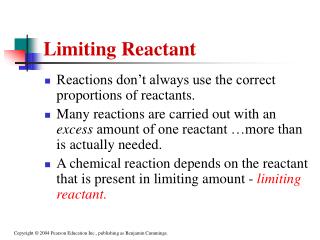

Another way is to calculate the grams of products produced from the given quantities of reactants the reactant that produces the smallest amount of product is the limiting reagent (approach 2).Įxample \(\PageIndex\) To determine the amount of excess H 2 remaining, calculate how much H 2 is needed to produce 108 grams of H 2 O. After 108 grams of H 2 O forms, the reaction stops. One method is to find and compare the mole ratio of the reactants used in the reaction (approach 1). Much more water is formed from 20 grams of H 2 than 96 grams of O 2.Oxygen is the limiting reactant. There are two ways to determine the limiting reagent. The limiting reagent is the one that is totally consumed it limits the reaction from continuing because there is none left to react with the in-excess reactant. If the reactants are not mixed in the correct stoichiometric proportions (as indicated by the balanced chemical equation), then one of the reactants will be entirely consumed while another will be left over. From the reaction stoichiometry, the exact amount of reactant needed to react with another element can be calculated. The limiting reagent is the reactant that is completely used up in a reaction, and thus determines when the reaction stops. Because there are not enough tires (20 tires is less than the 28 required), tires are the limiting "reactant." For 20 tires, 10 headlights are required, whereas for 14 headlights, 28 tires are required. There are 20 tires and 14 headlights, so there are two ways of looking at this problem. The reactants must thus occur in that ratio otherwise, one will limit the reaction. The initial condition is that there must be 4 tires to 2 headlights. Images used from Wikipedia with permission. This scenario is illustrated below:Ĥ Tires + 2 Headlights = 1 Car + = Figure 1: The synthesis reaction of making a car.

How to change limiting reactant on chem draw full#
Because the number of cars formed by 20 tires is less than number of cars produced by 14 headlights, the tires are the limiting reagent (they limit the full completion of the reaction, in which all of the reactants are used up). In this case, the headlights are in excess. Although more cars can be made from the headlights available, only 5 full cars are possible because of the limited number of tires available. With 14 headlights, 7 cars can be built (each car needs 2 headlights). If you have 20 tires and 14 headlights, how many cars can be made? With 20 tires, 5 cars can be produced because there are 4 tires to a car. In this example, imagine that the tires and headlights are reactants while the car is the product formed from the reaction of 4 tires and 2 headlights. In order to assemble a car, 4 tires and 2 headlights are needed (among other things). The following scenario illustrates the significance of limiting reagents.


 0 kommentar(er)
0 kommentar(er)
